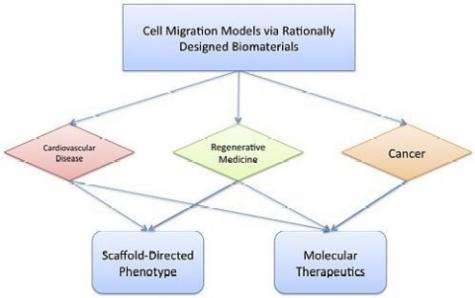Engineer builds tissue models to study diseases

Shelly Peyton, a chemical engineer at the University of Massachusetts Amherst, is building working models of human bone, breast, liver and artery tissues to see how cells behave when they are affected by a disease such as cancer. The ultimate goal of the research is to develop new drug therapies to fight diseases with a streamlined testing regimen that may not require animal testing, she says.
Peyton creates testing platforms from polymers that have many key aspects of human tissues. When the artificial tissues are subject to real cancer cells, she says, it’s possible to see how the disease develops and how cells move in those diseased tissues. By understanding the physical and chemical properties of both the diseased cells and the host environment, Peyton hopes to discover how and why cancer cells move to other parts of the body, a process called metastasis. She is also looking at how cells read and generate signals inside human tissues that trigger movements and change.
It’s her dual role as biologist and an engineer that has opened up this type of research, Peyton says. "We are biologists enough where we can study cancer," she says, "and we’re materials scientists enough to make the polymer platforms."
She says mixing the two disciplines, something she focused on while a graduate student and postdoctoral fellow at the University of California, Irvine and MIT, has opened up a huge new field of research. "I’m surprised more scientists aren’t doing this," Peyton says.
One key to the process is creating the host materials, she says. She is working with UMass Amherst faculty members in the department of polymer science and engineering to build the tissue platforms that meet different conditions. Currently in her lab, she and her associates have constructed a range of tissue models. These include liver tissues, both healthy and inflamed tissue; cardiovascular tissues, again both healthy and with plaque buildup, and breast tissue
"These models act as a substitute for using animals to study disease in the lab. We can make tissues that look very much like a tissue would look like in an animal," she says.
When cancer cells are introduced to the tissues, Peyton and her team can observe how they adapt to the environment and how they develop. They are also looking for chemical and environmental triggers that signal the cells about when and where to move, she says.
An overarching goal of the research is to find a new testing sequence for drug therapies, Peyton says. Currently, drugs are first tested in a laboratory in an environment composed of plastic or glass dishes. The next level of testing is done in animals, and finally drugs are tested in humans. Peyton says that sequence of testing is useful, but she also points out that how a drug interacts on glass, then in animals, may have little to do with how it performs in humans.
"We are studying a lot of cellular mechanisms," Peyton says. "Not only the response and how they migrate, but what’s going on internally with the cell."
She says many scientists are interested in questions of cell motility, or movement, in the cell biology field. Her work combines that interest with materials science and engineering in developing the new testing tissues.
Provided by University of Massachusetts Amherst

















